Improvement of Supply Chain Management: A Case Study Analysis
VerifiedAdded on 2021/02/21
|33
|13069
|84
Report
AI Summary
This report explores the improvement of supply chain management (SCM) through the application of Advanced Planning Systems (APS). It begins with an introduction defining SCM and its significance, emphasizing the need for integration with APS to enhance effectiveness. The report outlines the aim, research objectives, and questions, followed by a literature review covering SCM, its benefits, and the effectiveness of APS techniques. The methodology section details the data analysis, collection methods, research design, and approach. A case study on Pepsico, a leading multinational food and beverage corporation, is presented to analyze the practical application of APS in improving supply chain operations. The report examines the structure of Pepsico's supply chain, the benefits of APS, and how they contribute to the company's long-term success. The conclusion and recommendations provide insights into the challenges and benefits of adopting APS, offering guidance for business organizations and market researchers to understand the role of supply chains in business success. The report emphasizes the importance of effective SCM, and the use of APS techniques for optimizing supply chains, improving efficiency, and achieving long-term organizational goals.
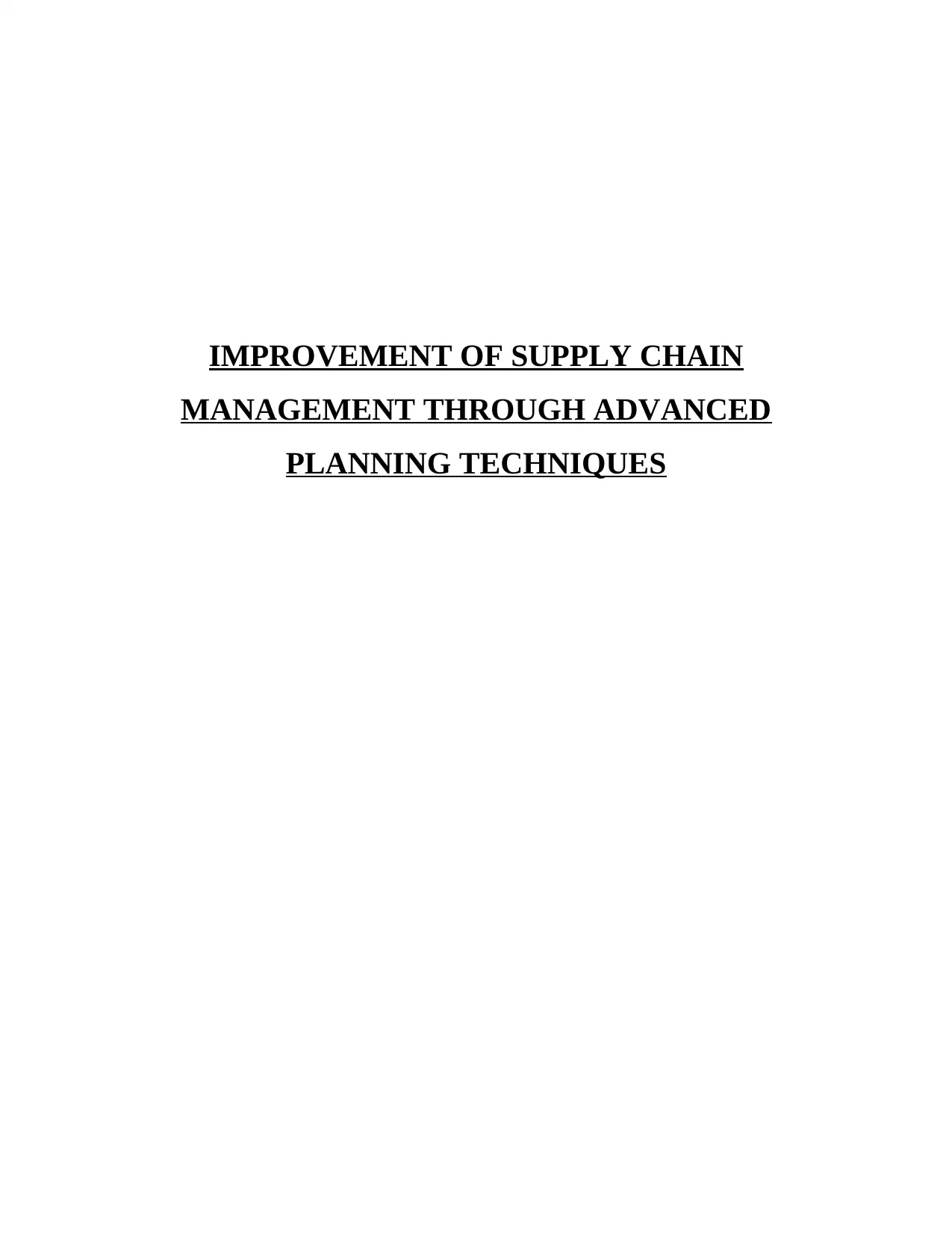
IMPROVEMENT OF SUPPLY CHAIN
MANAGEMENT THROUGH ADVANCED
PLANNING TECHNIQUES
MANAGEMENT THROUGH ADVANCED
PLANNING TECHNIQUES
Paraphrase This Document
Need a fresh take? Get an instant paraphrase of this document with our AI Paraphraser
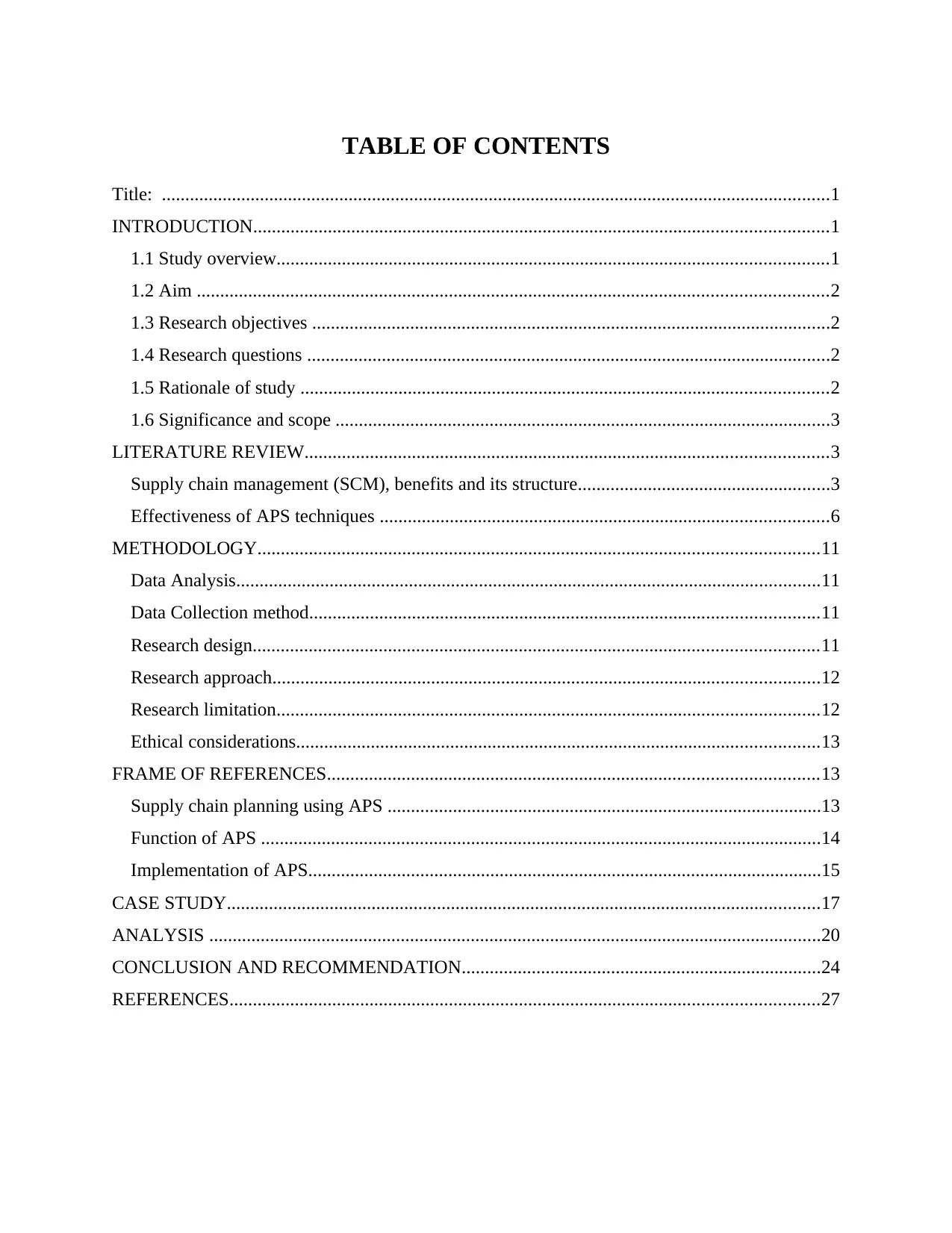
TABLE OF CONTENTS
Title: ...............................................................................................................................................1
INTRODUCTION...........................................................................................................................1
1.1 Study overview......................................................................................................................1
1.2 Aim .......................................................................................................................................2
1.3 Research objectives ...............................................................................................................2
1.4 Research questions ................................................................................................................2
1.5 Rationale of study .................................................................................................................2
1.6 Significance and scope ..........................................................................................................3
LITERATURE REVIEW................................................................................................................3
Supply chain management (SCM), benefits and its structure......................................................3
Effectiveness of APS techniques ................................................................................................6
METHODOLOGY........................................................................................................................11
Data Analysis.............................................................................................................................11
Data Collection method.............................................................................................................11
Research design.........................................................................................................................11
Research approach.....................................................................................................................12
Research limitation....................................................................................................................12
Ethical considerations................................................................................................................13
FRAME OF REFERENCES.........................................................................................................13
Supply chain planning using APS .............................................................................................13
Function of APS ........................................................................................................................14
Implementation of APS..............................................................................................................15
CASE STUDY...............................................................................................................................17
ANALYSIS ...................................................................................................................................20
CONCLUSION AND RECOMMENDATION.............................................................................24
REFERENCES..............................................................................................................................27
Title: ...............................................................................................................................................1
INTRODUCTION...........................................................................................................................1
1.1 Study overview......................................................................................................................1
1.2 Aim .......................................................................................................................................2
1.3 Research objectives ...............................................................................................................2
1.4 Research questions ................................................................................................................2
1.5 Rationale of study .................................................................................................................2
1.6 Significance and scope ..........................................................................................................3
LITERATURE REVIEW................................................................................................................3
Supply chain management (SCM), benefits and its structure......................................................3
Effectiveness of APS techniques ................................................................................................6
METHODOLOGY........................................................................................................................11
Data Analysis.............................................................................................................................11
Data Collection method.............................................................................................................11
Research design.........................................................................................................................11
Research approach.....................................................................................................................12
Research limitation....................................................................................................................12
Ethical considerations................................................................................................................13
FRAME OF REFERENCES.........................................................................................................13
Supply chain planning using APS .............................................................................................13
Function of APS ........................................................................................................................14
Implementation of APS..............................................................................................................15
CASE STUDY...............................................................................................................................17
ANALYSIS ...................................................................................................................................20
CONCLUSION AND RECOMMENDATION.............................................................................24
REFERENCES..............................................................................................................................27
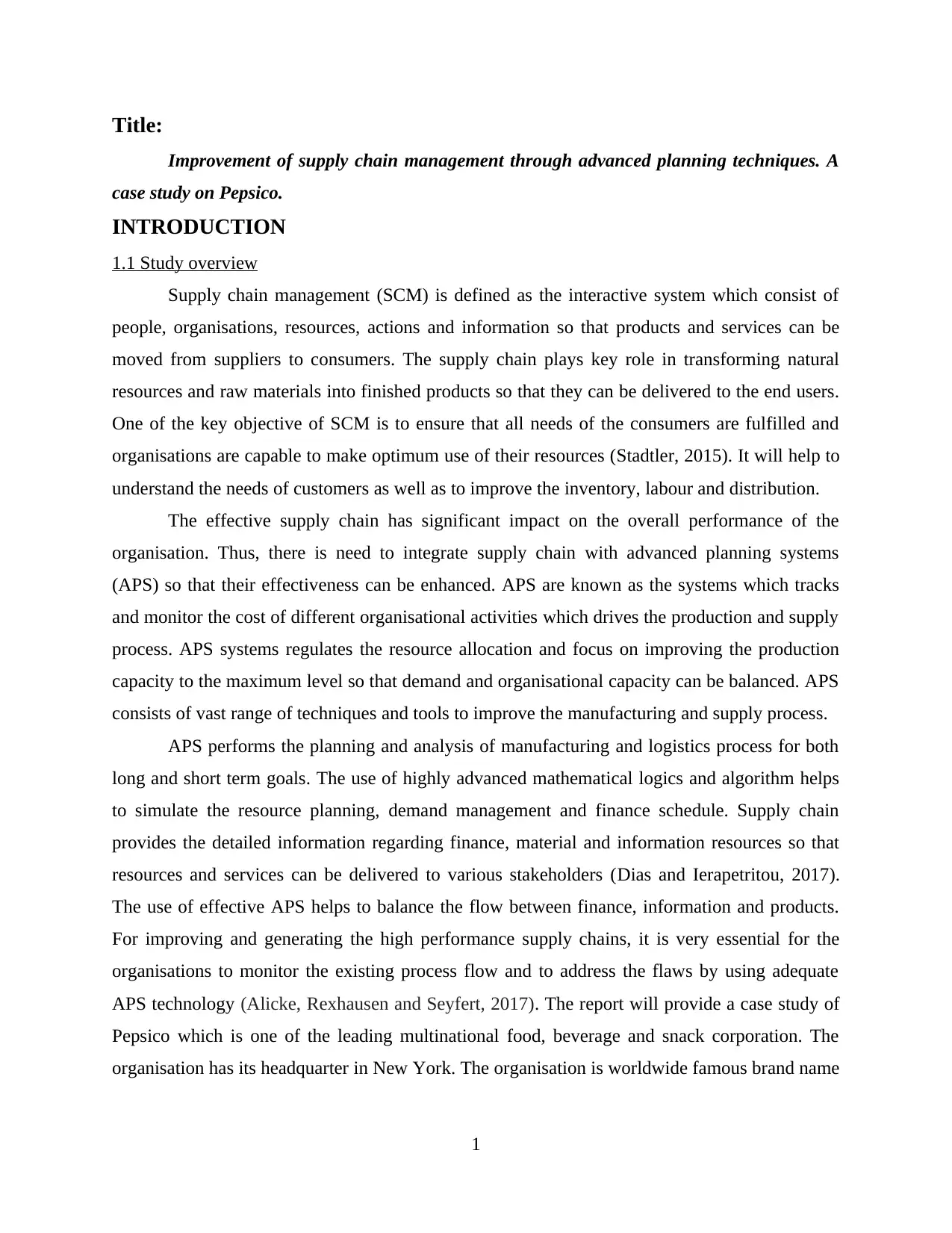
Title:
Improvement of supply chain management through advanced planning techniques. A
case study on Pepsico.
INTRODUCTION
1.1 Study overview
Supply chain management (SCM) is defined as the interactive system which consist of
people, organisations, resources, actions and information so that products and services can be
moved from suppliers to consumers. The supply chain plays key role in transforming natural
resources and raw materials into finished products so that they can be delivered to the end users.
One of the key objective of SCM is to ensure that all needs of the consumers are fulfilled and
organisations are capable to make optimum use of their resources (Stadtler, 2015). It will help to
understand the needs of customers as well as to improve the inventory, labour and distribution.
The effective supply chain has significant impact on the overall performance of the
organisation. Thus, there is need to integrate supply chain with advanced planning systems
(APS) so that their effectiveness can be enhanced. APS are known as the systems which tracks
and monitor the cost of different organisational activities which drives the production and supply
process. APS systems regulates the resource allocation and focus on improving the production
capacity to the maximum level so that demand and organisational capacity can be balanced. APS
consists of vast range of techniques and tools to improve the manufacturing and supply process.
APS performs the planning and analysis of manufacturing and logistics process for both
long and short term goals. The use of highly advanced mathematical logics and algorithm helps
to simulate the resource planning, demand management and finance schedule. Supply chain
provides the detailed information regarding finance, material and information resources so that
resources and services can be delivered to various stakeholders (Dias and Ierapetritou, 2017).
The use of effective APS helps to balance the flow between finance, information and products.
For improving and generating the high performance supply chains, it is very essential for the
organisations to monitor the existing process flow and to address the flaws by using adequate
APS technology (Alicke, Rexhausen and Seyfert, 2017). The report will provide a case study of
Pepsico which is one of the leading multinational food, beverage and snack corporation. The
organisation has its headquarter in New York. The organisation is worldwide famous brand name
1
Improvement of supply chain management through advanced planning techniques. A
case study on Pepsico.
INTRODUCTION
1.1 Study overview
Supply chain management (SCM) is defined as the interactive system which consist of
people, organisations, resources, actions and information so that products and services can be
moved from suppliers to consumers. The supply chain plays key role in transforming natural
resources and raw materials into finished products so that they can be delivered to the end users.
One of the key objective of SCM is to ensure that all needs of the consumers are fulfilled and
organisations are capable to make optimum use of their resources (Stadtler, 2015). It will help to
understand the needs of customers as well as to improve the inventory, labour and distribution.
The effective supply chain has significant impact on the overall performance of the
organisation. Thus, there is need to integrate supply chain with advanced planning systems
(APS) so that their effectiveness can be enhanced. APS are known as the systems which tracks
and monitor the cost of different organisational activities which drives the production and supply
process. APS systems regulates the resource allocation and focus on improving the production
capacity to the maximum level so that demand and organisational capacity can be balanced. APS
consists of vast range of techniques and tools to improve the manufacturing and supply process.
APS performs the planning and analysis of manufacturing and logistics process for both
long and short term goals. The use of highly advanced mathematical logics and algorithm helps
to simulate the resource planning, demand management and finance schedule. Supply chain
provides the detailed information regarding finance, material and information resources so that
resources and services can be delivered to various stakeholders (Dias and Ierapetritou, 2017).
The use of effective APS helps to balance the flow between finance, information and products.
For improving and generating the high performance supply chains, it is very essential for the
organisations to monitor the existing process flow and to address the flaws by using adequate
APS technology (Alicke, Rexhausen and Seyfert, 2017). The report will provide a case study of
Pepsico which is one of the leading multinational food, beverage and snack corporation. The
organisation has its headquarter in New York. The organisation is worldwide famous brand name
1
⊘ This is a preview!⊘
Do you want full access?
Subscribe today to unlock all pages.

Trusted by 1+ million students worldwide
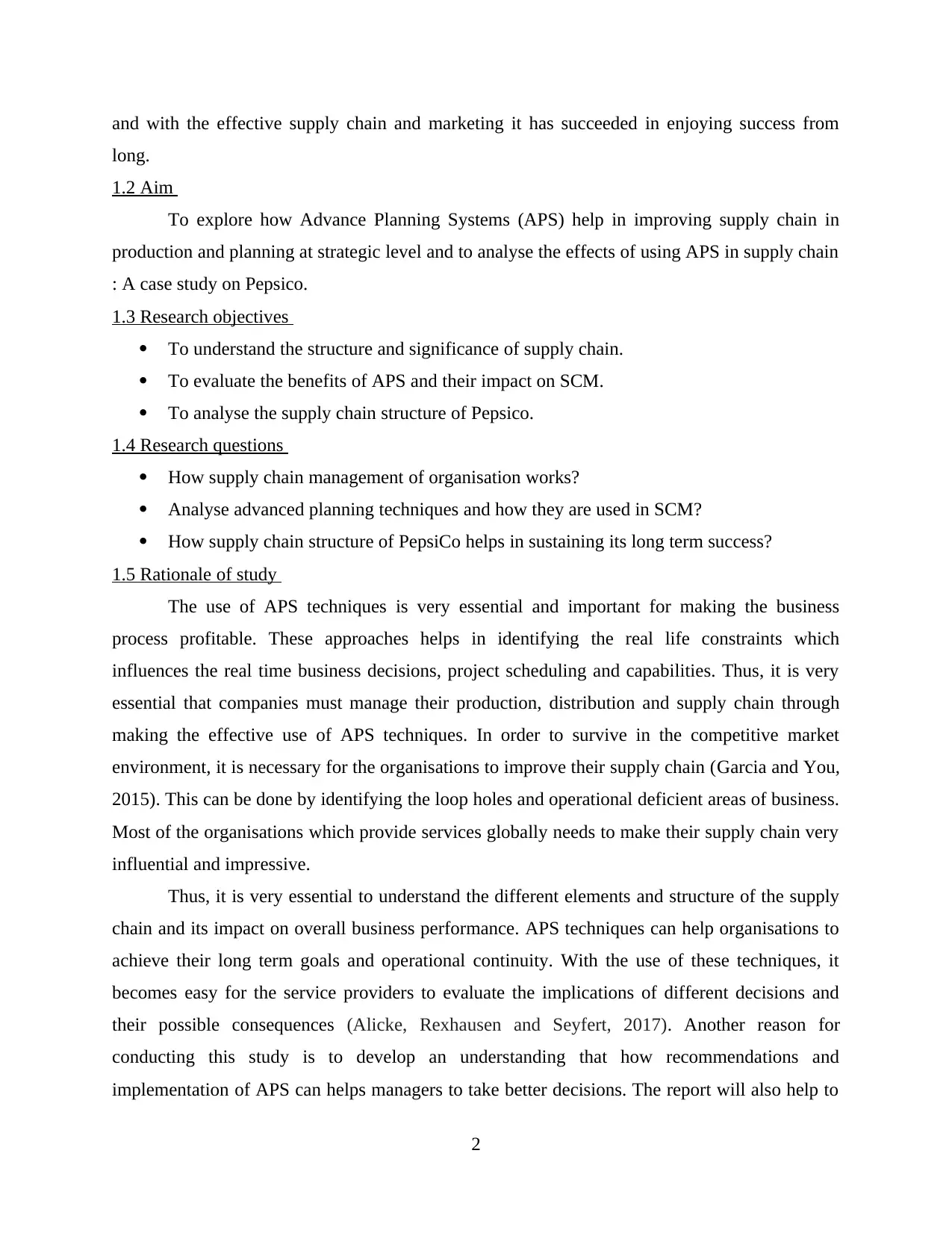
and with the effective supply chain and marketing it has succeeded in enjoying success from
long.
1.2 Aim
To explore how Advance Planning Systems (APS) help in improving supply chain in
production and planning at strategic level and to analyse the effects of using APS in supply chain
: A case study on Pepsico.
1.3 Research objectives
To understand the structure and significance of supply chain.
To evaluate the benefits of APS and their impact on SCM.
To analyse the supply chain structure of Pepsico.
1.4 Research questions
How supply chain management of organisation works?
Analyse advanced planning techniques and how they are used in SCM?
How supply chain structure of PepsiCo helps in sustaining its long term success?
1.5 Rationale of study
The use of APS techniques is very essential and important for making the business
process profitable. These approaches helps in identifying the real life constraints which
influences the real time business decisions, project scheduling and capabilities. Thus, it is very
essential that companies must manage their production, distribution and supply chain through
making the effective use of APS techniques. In order to survive in the competitive market
environment, it is necessary for the organisations to improve their supply chain (Garcia and You,
2015). This can be done by identifying the loop holes and operational deficient areas of business.
Most of the organisations which provide services globally needs to make their supply chain very
influential and impressive.
Thus, it is very essential to understand the different elements and structure of the supply
chain and its impact on overall business performance. APS techniques can help organisations to
achieve their long term goals and operational continuity. With the use of these techniques, it
becomes easy for the service providers to evaluate the implications of different decisions and
their possible consequences (Alicke, Rexhausen and Seyfert, 2017). Another reason for
conducting this study is to develop an understanding that how recommendations and
implementation of APS can helps managers to take better decisions. The report will also help to
2
long.
1.2 Aim
To explore how Advance Planning Systems (APS) help in improving supply chain in
production and planning at strategic level and to analyse the effects of using APS in supply chain
: A case study on Pepsico.
1.3 Research objectives
To understand the structure and significance of supply chain.
To evaluate the benefits of APS and their impact on SCM.
To analyse the supply chain structure of Pepsico.
1.4 Research questions
How supply chain management of organisation works?
Analyse advanced planning techniques and how they are used in SCM?
How supply chain structure of PepsiCo helps in sustaining its long term success?
1.5 Rationale of study
The use of APS techniques is very essential and important for making the business
process profitable. These approaches helps in identifying the real life constraints which
influences the real time business decisions, project scheduling and capabilities. Thus, it is very
essential that companies must manage their production, distribution and supply chain through
making the effective use of APS techniques. In order to survive in the competitive market
environment, it is necessary for the organisations to improve their supply chain (Garcia and You,
2015). This can be done by identifying the loop holes and operational deficient areas of business.
Most of the organisations which provide services globally needs to make their supply chain very
influential and impressive.
Thus, it is very essential to understand the different elements and structure of the supply
chain and its impact on overall business performance. APS techniques can help organisations to
achieve their long term goals and operational continuity. With the use of these techniques, it
becomes easy for the service providers to evaluate the implications of different decisions and
their possible consequences (Alicke, Rexhausen and Seyfert, 2017). Another reason for
conducting this study is to develop an understanding that how recommendations and
implementation of APS can helps managers to take better decisions. The report will also help to
2
Paraphrase This Document
Need a fresh take? Get an instant paraphrase of this document with our AI Paraphraser
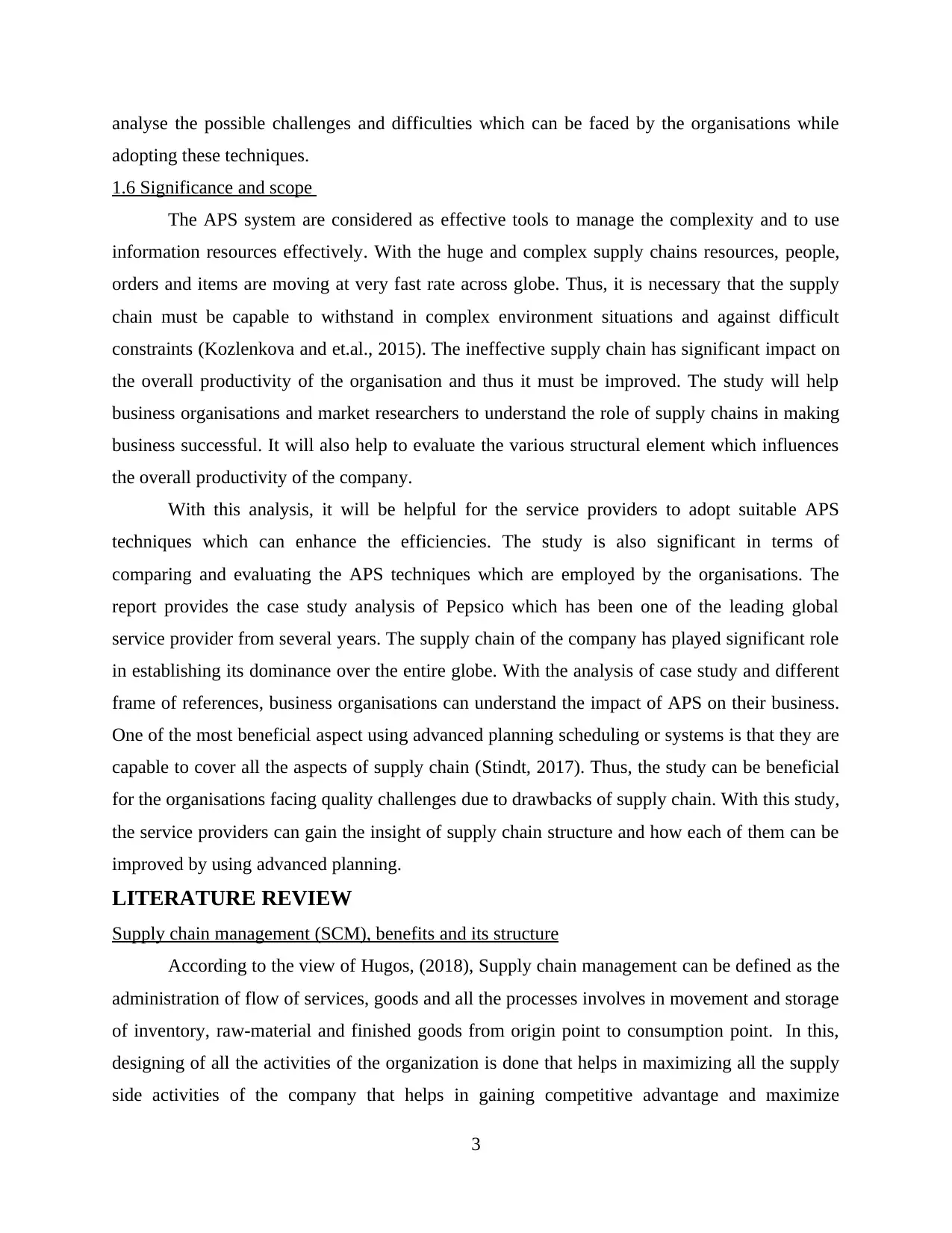
analyse the possible challenges and difficulties which can be faced by the organisations while
adopting these techniques.
1.6 Significance and scope
The APS system are considered as effective tools to manage the complexity and to use
information resources effectively. With the huge and complex supply chains resources, people,
orders and items are moving at very fast rate across globe. Thus, it is necessary that the supply
chain must be capable to withstand in complex environment situations and against difficult
constraints (Kozlenkova and et.al., 2015). The ineffective supply chain has significant impact on
the overall productivity of the organisation and thus it must be improved. The study will help
business organisations and market researchers to understand the role of supply chains in making
business successful. It will also help to evaluate the various structural element which influences
the overall productivity of the company.
With this analysis, it will be helpful for the service providers to adopt suitable APS
techniques which can enhance the efficiencies. The study is also significant in terms of
comparing and evaluating the APS techniques which are employed by the organisations. The
report provides the case study analysis of Pepsico which has been one of the leading global
service provider from several years. The supply chain of the company has played significant role
in establishing its dominance over the entire globe. With the analysis of case study and different
frame of references, business organisations can understand the impact of APS on their business.
One of the most beneficial aspect using advanced planning scheduling or systems is that they are
capable to cover all the aspects of supply chain (Stindt, 2017). Thus, the study can be beneficial
for the organisations facing quality challenges due to drawbacks of supply chain. With this study,
the service providers can gain the insight of supply chain structure and how each of them can be
improved by using advanced planning.
LITERATURE REVIEW
Supply chain management (SCM), benefits and its structure
According to the view of Hugos, (2018), Supply chain management can be defined as the
administration of flow of services, goods and all the processes involves in movement and storage
of inventory, raw-material and finished goods from origin point to consumption point. In this,
designing of all the activities of the organization is done that helps in maximizing all the supply
side activities of the company that helps in gaining competitive advantage and maximize
3
adopting these techniques.
1.6 Significance and scope
The APS system are considered as effective tools to manage the complexity and to use
information resources effectively. With the huge and complex supply chains resources, people,
orders and items are moving at very fast rate across globe. Thus, it is necessary that the supply
chain must be capable to withstand in complex environment situations and against difficult
constraints (Kozlenkova and et.al., 2015). The ineffective supply chain has significant impact on
the overall productivity of the organisation and thus it must be improved. The study will help
business organisations and market researchers to understand the role of supply chains in making
business successful. It will also help to evaluate the various structural element which influences
the overall productivity of the company.
With this analysis, it will be helpful for the service providers to adopt suitable APS
techniques which can enhance the efficiencies. The study is also significant in terms of
comparing and evaluating the APS techniques which are employed by the organisations. The
report provides the case study analysis of Pepsico which has been one of the leading global
service provider from several years. The supply chain of the company has played significant role
in establishing its dominance over the entire globe. With the analysis of case study and different
frame of references, business organisations can understand the impact of APS on their business.
One of the most beneficial aspect using advanced planning scheduling or systems is that they are
capable to cover all the aspects of supply chain (Stindt, 2017). Thus, the study can be beneficial
for the organisations facing quality challenges due to drawbacks of supply chain. With this study,
the service providers can gain the insight of supply chain structure and how each of them can be
improved by using advanced planning.
LITERATURE REVIEW
Supply chain management (SCM), benefits and its structure
According to the view of Hugos, (2018), Supply chain management can be defined as the
administration of flow of services, goods and all the processes involves in movement and storage
of inventory, raw-material and finished goods from origin point to consumption point. In this,
designing of all the activities of the organization is done that helps in maximizing all the supply
side activities of the company that helps in gaining competitive advantage and maximize
3
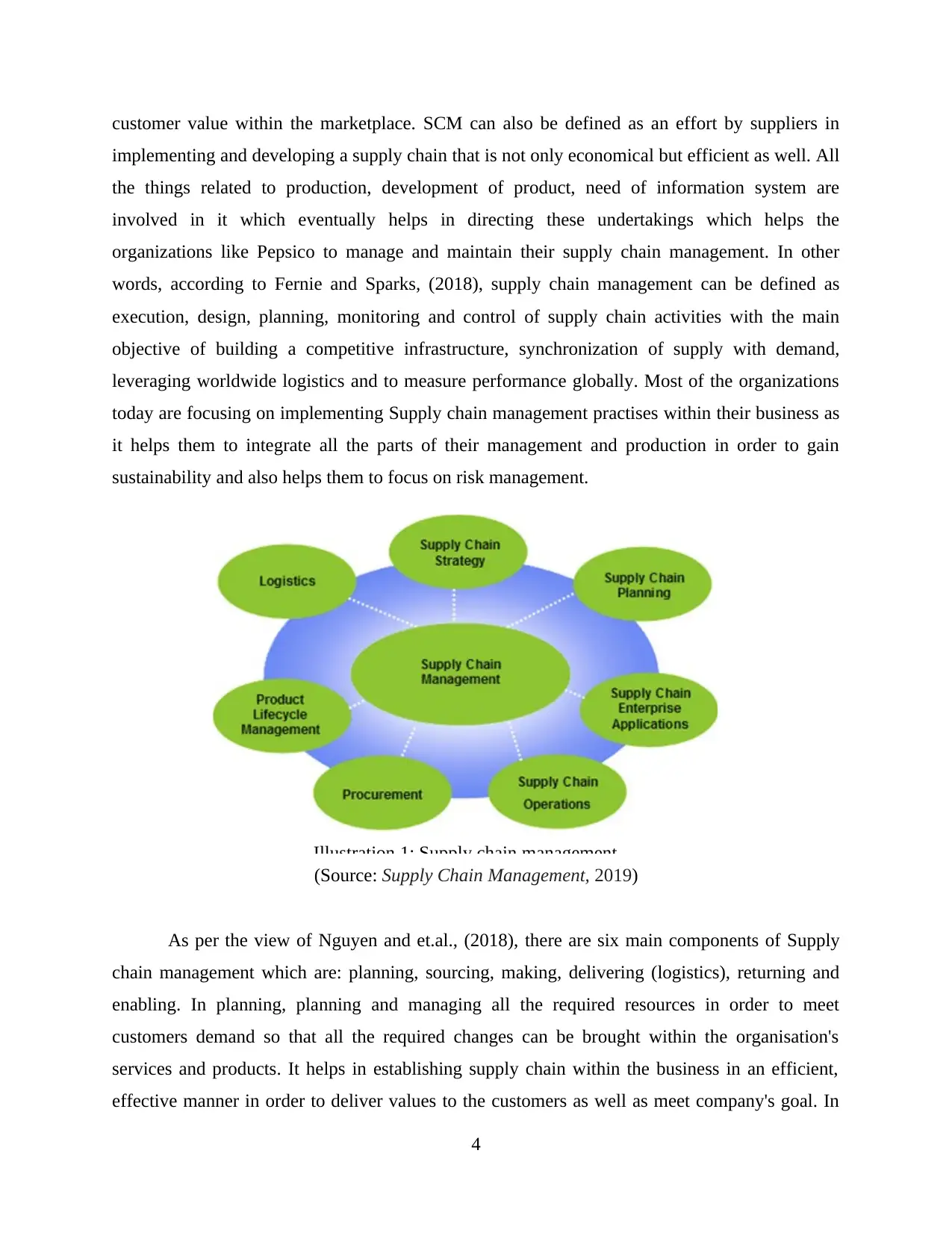
customer value within the marketplace. SCM can also be defined as an effort by suppliers in
implementing and developing a supply chain that is not only economical but efficient as well. All
the things related to production, development of product, need of information system are
involved in it which eventually helps in directing these undertakings which helps the
organizations like Pepsico to manage and maintain their supply chain management. In other
words, according to Fernie and Sparks, (2018), supply chain management can be defined as
execution, design, planning, monitoring and control of supply chain activities with the main
objective of building a competitive infrastructure, synchronization of supply with demand,
leveraging worldwide logistics and to measure performance globally. Most of the organizations
today are focusing on implementing Supply chain management practises within their business as
it helps them to integrate all the parts of their management and production in order to gain
sustainability and also helps them to focus on risk management.
(Source: Supply Chain Management, 2019)
As per the view of Nguyen and et.al., (2018), there are six main components of Supply
chain management which are: planning, sourcing, making, delivering (logistics), returning and
enabling. In planning, planning and managing all the required resources in order to meet
customers demand so that all the required changes can be brought within the organisation's
services and products. It helps in establishing supply chain within the business in an efficient,
effective manner in order to deliver values to the customers as well as meet company's goal. In
4
Illustration 1: Supply chain management
implementing and developing a supply chain that is not only economical but efficient as well. All
the things related to production, development of product, need of information system are
involved in it which eventually helps in directing these undertakings which helps the
organizations like Pepsico to manage and maintain their supply chain management. In other
words, according to Fernie and Sparks, (2018), supply chain management can be defined as
execution, design, planning, monitoring and control of supply chain activities with the main
objective of building a competitive infrastructure, synchronization of supply with demand,
leveraging worldwide logistics and to measure performance globally. Most of the organizations
today are focusing on implementing Supply chain management practises within their business as
it helps them to integrate all the parts of their management and production in order to gain
sustainability and also helps them to focus on risk management.
(Source: Supply Chain Management, 2019)
As per the view of Nguyen and et.al., (2018), there are six main components of Supply
chain management which are: planning, sourcing, making, delivering (logistics), returning and
enabling. In planning, planning and managing all the required resources in order to meet
customers demand so that all the required changes can be brought within the organisation's
services and products. It helps in establishing supply chain within the business in an efficient,
effective manner in order to deliver values to the customers as well as meet company's goal. In
4
Illustration 1: Supply chain management
⊘ This is a preview!⊘
Do you want full access?
Subscribe today to unlock all pages.

Trusted by 1+ million students worldwide
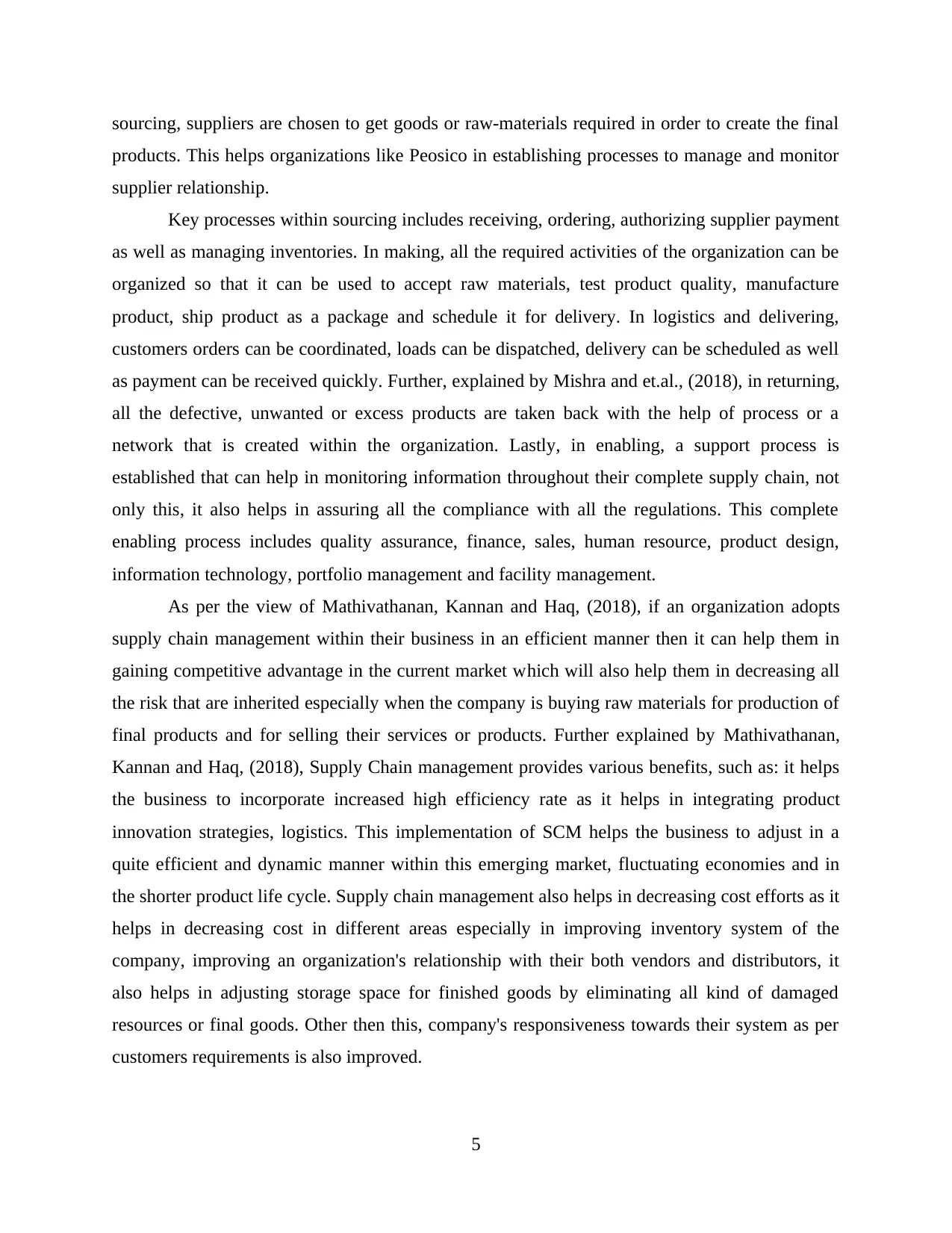
sourcing, suppliers are chosen to get goods or raw-materials required in order to create the final
products. This helps organizations like Peosico in establishing processes to manage and monitor
supplier relationship.
Key processes within sourcing includes receiving, ordering, authorizing supplier payment
as well as managing inventories. In making, all the required activities of the organization can be
organized so that it can be used to accept raw materials, test product quality, manufacture
product, ship product as a package and schedule it for delivery. In logistics and delivering,
customers orders can be coordinated, loads can be dispatched, delivery can be scheduled as well
as payment can be received quickly. Further, explained by Mishra and et.al., (2018), in returning,
all the defective, unwanted or excess products are taken back with the help of process or a
network that is created within the organization. Lastly, in enabling, a support process is
established that can help in monitoring information throughout their complete supply chain, not
only this, it also helps in assuring all the compliance with all the regulations. This complete
enabling process includes quality assurance, finance, sales, human resource, product design,
information technology, portfolio management and facility management.
As per the view of Mathivathanan, Kannan and Haq, (2018), if an organization adopts
supply chain management within their business in an efficient manner then it can help them in
gaining competitive advantage in the current market which will also help them in decreasing all
the risk that are inherited especially when the company is buying raw materials for production of
final products and for selling their services or products. Further explained by Mathivathanan,
Kannan and Haq, (2018), Supply Chain management provides various benefits, such as: it helps
the business to incorporate increased high efficiency rate as it helps in integrating product
innovation strategies, logistics. This implementation of SCM helps the business to adjust in a
quite efficient and dynamic manner within this emerging market, fluctuating economies and in
the shorter product life cycle. Supply chain management also helps in decreasing cost efforts as it
helps in decreasing cost in different areas especially in improving inventory system of the
company, improving an organization's relationship with their both vendors and distributors, it
also helps in adjusting storage space for finished goods by eliminating all kind of damaged
resources or final goods. Other then this, company's responsiveness towards their system as per
customers requirements is also improved.
5
products. This helps organizations like Peosico in establishing processes to manage and monitor
supplier relationship.
Key processes within sourcing includes receiving, ordering, authorizing supplier payment
as well as managing inventories. In making, all the required activities of the organization can be
organized so that it can be used to accept raw materials, test product quality, manufacture
product, ship product as a package and schedule it for delivery. In logistics and delivering,
customers orders can be coordinated, loads can be dispatched, delivery can be scheduled as well
as payment can be received quickly. Further, explained by Mishra and et.al., (2018), in returning,
all the defective, unwanted or excess products are taken back with the help of process or a
network that is created within the organization. Lastly, in enabling, a support process is
established that can help in monitoring information throughout their complete supply chain, not
only this, it also helps in assuring all the compliance with all the regulations. This complete
enabling process includes quality assurance, finance, sales, human resource, product design,
information technology, portfolio management and facility management.
As per the view of Mathivathanan, Kannan and Haq, (2018), if an organization adopts
supply chain management within their business in an efficient manner then it can help them in
gaining competitive advantage in the current market which will also help them in decreasing all
the risk that are inherited especially when the company is buying raw materials for production of
final products and for selling their services or products. Further explained by Mathivathanan,
Kannan and Haq, (2018), Supply Chain management provides various benefits, such as: it helps
the business to incorporate increased high efficiency rate as it helps in integrating product
innovation strategies, logistics. This implementation of SCM helps the business to adjust in a
quite efficient and dynamic manner within this emerging market, fluctuating economies and in
the shorter product life cycle. Supply chain management also helps in decreasing cost efforts as it
helps in decreasing cost in different areas especially in improving inventory system of the
company, improving an organization's relationship with their both vendors and distributors, it
also helps in adjusting storage space for finished goods by eliminating all kind of damaged
resources or final goods. Other then this, company's responsiveness towards their system as per
customers requirements is also improved.
5
Paraphrase This Document
Need a fresh take? Get an instant paraphrase of this document with our AI Paraphraser
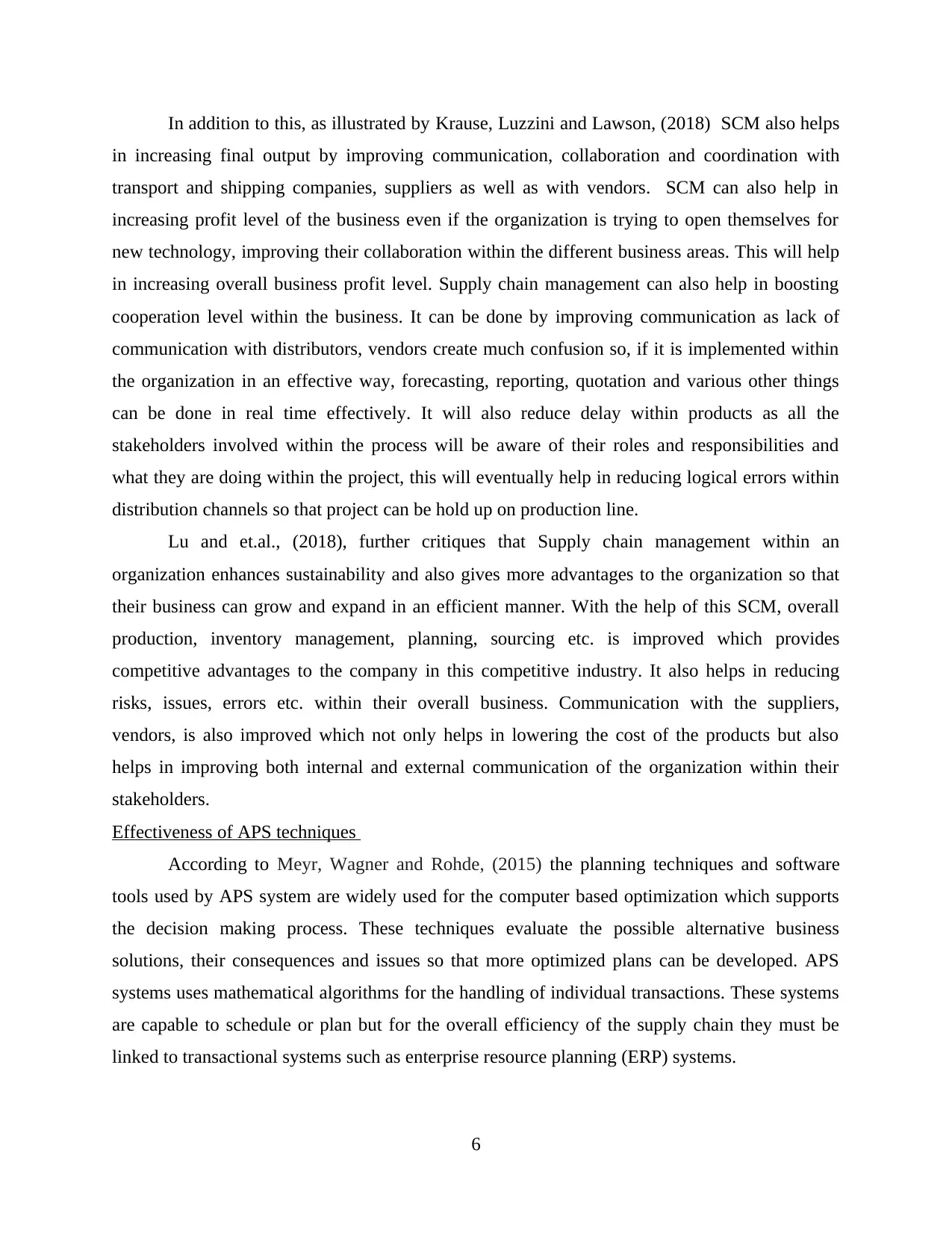
In addition to this, as illustrated by Krause, Luzzini and Lawson, (2018) SCM also helps
in increasing final output by improving communication, collaboration and coordination with
transport and shipping companies, suppliers as well as with vendors. SCM can also help in
increasing profit level of the business even if the organization is trying to open themselves for
new technology, improving their collaboration within the different business areas. This will help
in increasing overall business profit level. Supply chain management can also help in boosting
cooperation level within the business. It can be done by improving communication as lack of
communication with distributors, vendors create much confusion so, if it is implemented within
the organization in an effective way, forecasting, reporting, quotation and various other things
can be done in real time effectively. It will also reduce delay within products as all the
stakeholders involved within the process will be aware of their roles and responsibilities and
what they are doing within the project, this will eventually help in reducing logical errors within
distribution channels so that project can be hold up on production line.
Lu and et.al., (2018), further critiques that Supply chain management within an
organization enhances sustainability and also gives more advantages to the organization so that
their business can grow and expand in an efficient manner. With the help of this SCM, overall
production, inventory management, planning, sourcing etc. is improved which provides
competitive advantages to the company in this competitive industry. It also helps in reducing
risks, issues, errors etc. within their overall business. Communication with the suppliers,
vendors, is also improved which not only helps in lowering the cost of the products but also
helps in improving both internal and external communication of the organization within their
stakeholders.
Effectiveness of APS techniques
According to Meyr, Wagner and Rohde, (2015) the planning techniques and software
tools used by APS system are widely used for the computer based optimization which supports
the decision making process. These techniques evaluate the possible alternative business
solutions, their consequences and issues so that more optimized plans can be developed. APS
systems uses mathematical algorithms for the handling of individual transactions. These systems
are capable to schedule or plan but for the overall efficiency of the supply chain they must be
linked to transactional systems such as enterprise resource planning (ERP) systems.
6
in increasing final output by improving communication, collaboration and coordination with
transport and shipping companies, suppliers as well as with vendors. SCM can also help in
increasing profit level of the business even if the organization is trying to open themselves for
new technology, improving their collaboration within the different business areas. This will help
in increasing overall business profit level. Supply chain management can also help in boosting
cooperation level within the business. It can be done by improving communication as lack of
communication with distributors, vendors create much confusion so, if it is implemented within
the organization in an effective way, forecasting, reporting, quotation and various other things
can be done in real time effectively. It will also reduce delay within products as all the
stakeholders involved within the process will be aware of their roles and responsibilities and
what they are doing within the project, this will eventually help in reducing logical errors within
distribution channels so that project can be hold up on production line.
Lu and et.al., (2018), further critiques that Supply chain management within an
organization enhances sustainability and also gives more advantages to the organization so that
their business can grow and expand in an efficient manner. With the help of this SCM, overall
production, inventory management, planning, sourcing etc. is improved which provides
competitive advantages to the company in this competitive industry. It also helps in reducing
risks, issues, errors etc. within their overall business. Communication with the suppliers,
vendors, is also improved which not only helps in lowering the cost of the products but also
helps in improving both internal and external communication of the organization within their
stakeholders.
Effectiveness of APS techniques
According to Meyr, Wagner and Rohde, (2015) the planning techniques and software
tools used by APS system are widely used for the computer based optimization which supports
the decision making process. These techniques evaluate the possible alternative business
solutions, their consequences and issues so that more optimized plans can be developed. APS
systems uses mathematical algorithms for the handling of individual transactions. These systems
are capable to schedule or plan but for the overall efficiency of the supply chain they must be
linked to transactional systems such as enterprise resource planning (ERP) systems.
6
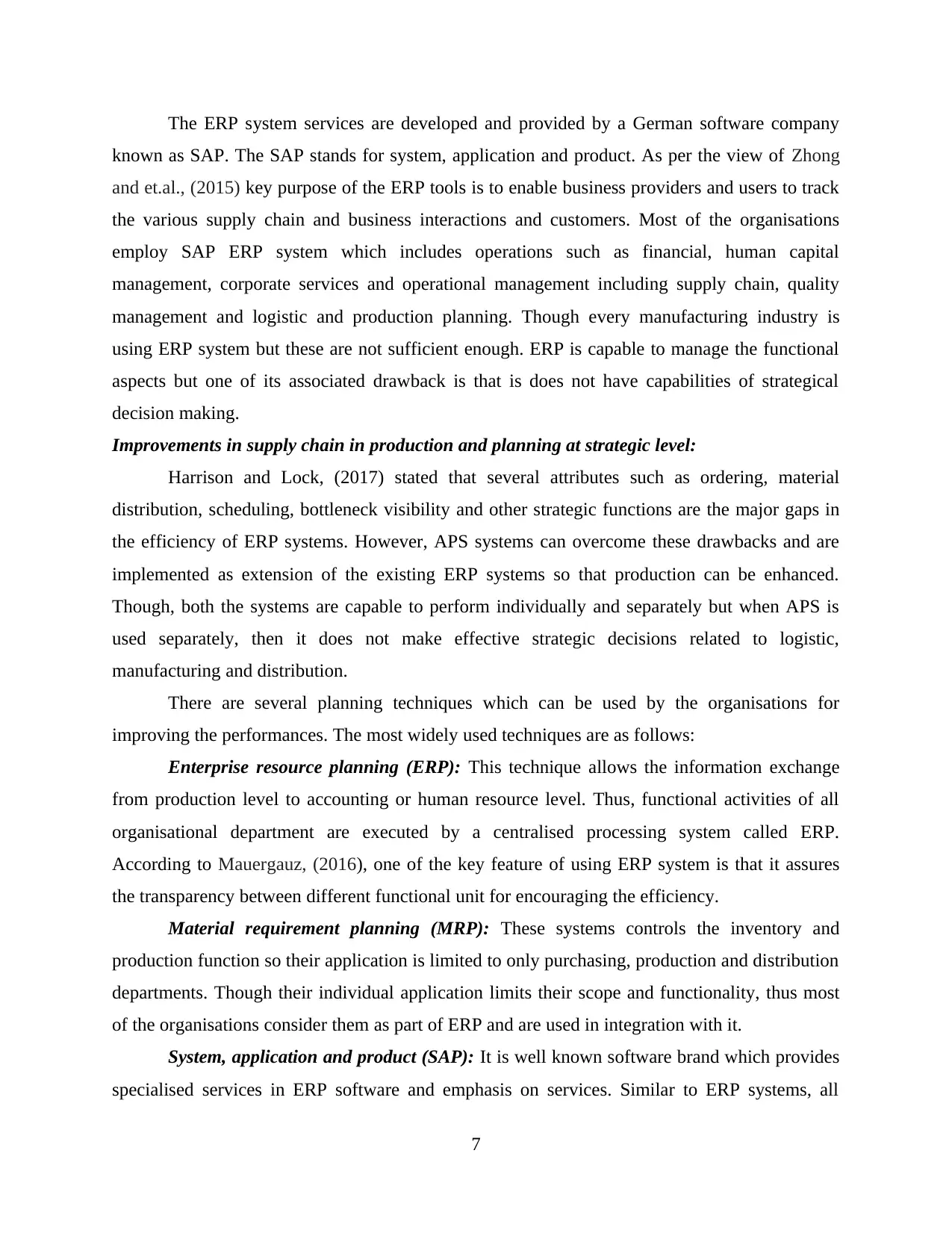
The ERP system services are developed and provided by a German software company
known as SAP. The SAP stands for system, application and product. As per the view of Zhong
and et.al., (2015) key purpose of the ERP tools is to enable business providers and users to track
the various supply chain and business interactions and customers. Most of the organisations
employ SAP ERP system which includes operations such as financial, human capital
management, corporate services and operational management including supply chain, quality
management and logistic and production planning. Though every manufacturing industry is
using ERP system but these are not sufficient enough. ERP is capable to manage the functional
aspects but one of its associated drawback is that is does not have capabilities of strategical
decision making.
Improvements in supply chain in production and planning at strategic level:
Harrison and Lock, (2017) stated that several attributes such as ordering, material
distribution, scheduling, bottleneck visibility and other strategic functions are the major gaps in
the efficiency of ERP systems. However, APS systems can overcome these drawbacks and are
implemented as extension of the existing ERP systems so that production can be enhanced.
Though, both the systems are capable to perform individually and separately but when APS is
used separately, then it does not make effective strategic decisions related to logistic,
manufacturing and distribution.
There are several planning techniques which can be used by the organisations for
improving the performances. The most widely used techniques are as follows:
Enterprise resource planning (ERP): This technique allows the information exchange
from production level to accounting or human resource level. Thus, functional activities of all
organisational department are executed by a centralised processing system called ERP.
According to Mauergauz, (2016), one of the key feature of using ERP system is that it assures
the transparency between different functional unit for encouraging the efficiency.
Material requirement planning (MRP): These systems controls the inventory and
production function so their application is limited to only purchasing, production and distribution
departments. Though their individual application limits their scope and functionality, thus most
of the organisations consider them as part of ERP and are used in integration with it.
System, application and product (SAP): It is well known software brand which provides
specialised services in ERP software and emphasis on services. Similar to ERP systems, all
7
known as SAP. The SAP stands for system, application and product. As per the view of Zhong
and et.al., (2015) key purpose of the ERP tools is to enable business providers and users to track
the various supply chain and business interactions and customers. Most of the organisations
employ SAP ERP system which includes operations such as financial, human capital
management, corporate services and operational management including supply chain, quality
management and logistic and production planning. Though every manufacturing industry is
using ERP system but these are not sufficient enough. ERP is capable to manage the functional
aspects but one of its associated drawback is that is does not have capabilities of strategical
decision making.
Improvements in supply chain in production and planning at strategic level:
Harrison and Lock, (2017) stated that several attributes such as ordering, material
distribution, scheduling, bottleneck visibility and other strategic functions are the major gaps in
the efficiency of ERP systems. However, APS systems can overcome these drawbacks and are
implemented as extension of the existing ERP systems so that production can be enhanced.
Though, both the systems are capable to perform individually and separately but when APS is
used separately, then it does not make effective strategic decisions related to logistic,
manufacturing and distribution.
There are several planning techniques which can be used by the organisations for
improving the performances. The most widely used techniques are as follows:
Enterprise resource planning (ERP): This technique allows the information exchange
from production level to accounting or human resource level. Thus, functional activities of all
organisational department are executed by a centralised processing system called ERP.
According to Mauergauz, (2016), one of the key feature of using ERP system is that it assures
the transparency between different functional unit for encouraging the efficiency.
Material requirement planning (MRP): These systems controls the inventory and
production function so their application is limited to only purchasing, production and distribution
departments. Though their individual application limits their scope and functionality, thus most
of the organisations consider them as part of ERP and are used in integration with it.
System, application and product (SAP): It is well known software brand which provides
specialised services in ERP software and emphasis on services. Similar to ERP systems, all
7
⊘ This is a preview!⊘
Do you want full access?
Subscribe today to unlock all pages.

Trusted by 1+ million students worldwide
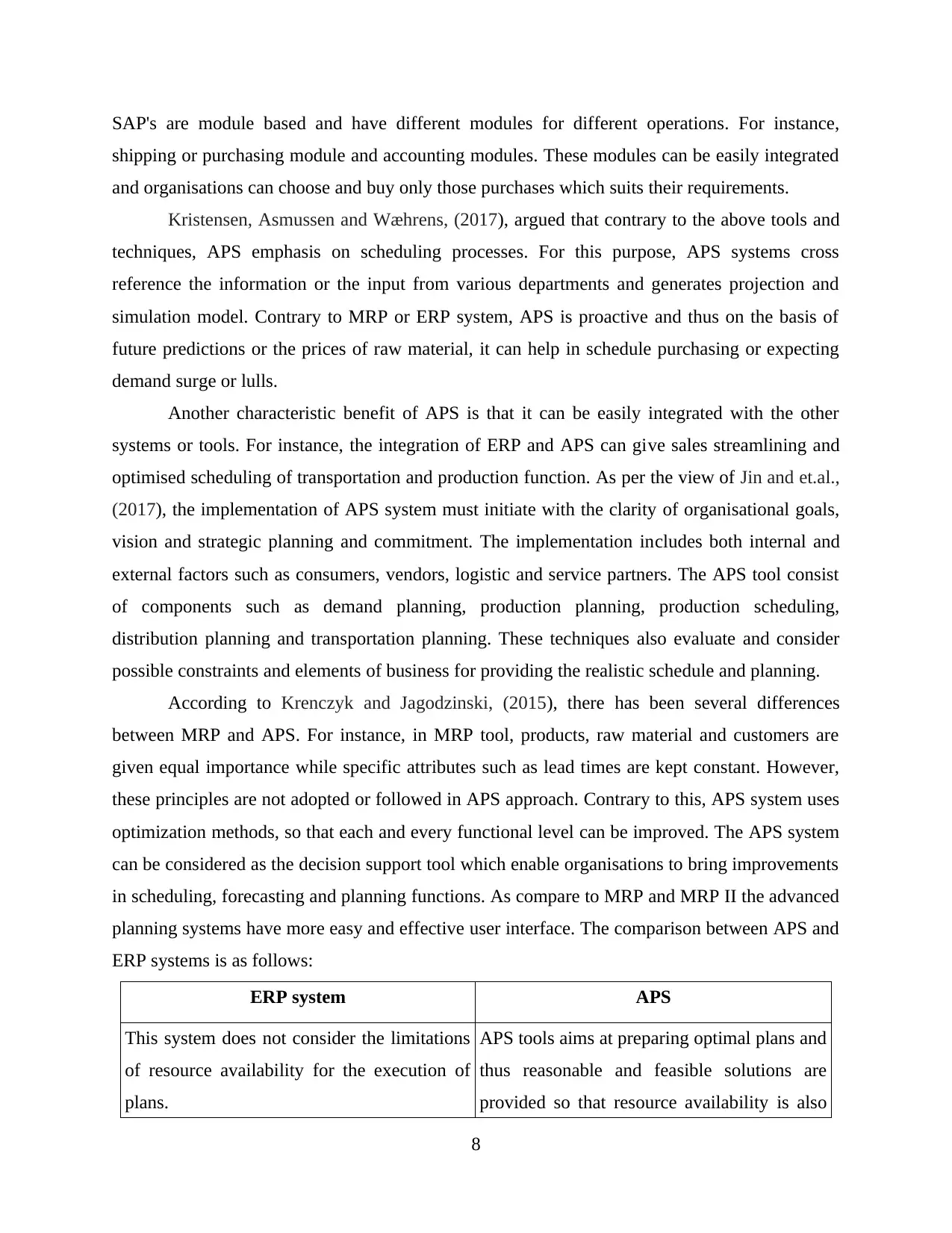
SAP's are module based and have different modules for different operations. For instance,
shipping or purchasing module and accounting modules. These modules can be easily integrated
and organisations can choose and buy only those purchases which suits their requirements.
Kristensen, Asmussen and Wæhrens, (2017), argued that contrary to the above tools and
techniques, APS emphasis on scheduling processes. For this purpose, APS systems cross
reference the information or the input from various departments and generates projection and
simulation model. Contrary to MRP or ERP system, APS is proactive and thus on the basis of
future predictions or the prices of raw material, it can help in schedule purchasing or expecting
demand surge or lulls.
Another characteristic benefit of APS is that it can be easily integrated with the other
systems or tools. For instance, the integration of ERP and APS can give sales streamlining and
optimised scheduling of transportation and production function. As per the view of Jin and et.al.,
(2017), the implementation of APS system must initiate with the clarity of organisational goals,
vision and strategic planning and commitment. The implementation includes both internal and
external factors such as consumers, vendors, logistic and service partners. The APS tool consist
of components such as demand planning, production planning, production scheduling,
distribution planning and transportation planning. These techniques also evaluate and consider
possible constraints and elements of business for providing the realistic schedule and planning.
According to Krenczyk and Jagodzinski, (2015), there has been several differences
between MRP and APS. For instance, in MRP tool, products, raw material and customers are
given equal importance while specific attributes such as lead times are kept constant. However,
these principles are not adopted or followed in APS approach. Contrary to this, APS system uses
optimization methods, so that each and every functional level can be improved. The APS system
can be considered as the decision support tool which enable organisations to bring improvements
in scheduling, forecasting and planning functions. As compare to MRP and MRP II the advanced
planning systems have more easy and effective user interface. The comparison between APS and
ERP systems is as follows:
ERP system APS
This system does not consider the limitations
of resource availability for the execution of
plans.
APS tools aims at preparing optimal plans and
thus reasonable and feasible solutions are
provided so that resource availability is also
8
shipping or purchasing module and accounting modules. These modules can be easily integrated
and organisations can choose and buy only those purchases which suits their requirements.
Kristensen, Asmussen and Wæhrens, (2017), argued that contrary to the above tools and
techniques, APS emphasis on scheduling processes. For this purpose, APS systems cross
reference the information or the input from various departments and generates projection and
simulation model. Contrary to MRP or ERP system, APS is proactive and thus on the basis of
future predictions or the prices of raw material, it can help in schedule purchasing or expecting
demand surge or lulls.
Another characteristic benefit of APS is that it can be easily integrated with the other
systems or tools. For instance, the integration of ERP and APS can give sales streamlining and
optimised scheduling of transportation and production function. As per the view of Jin and et.al.,
(2017), the implementation of APS system must initiate with the clarity of organisational goals,
vision and strategic planning and commitment. The implementation includes both internal and
external factors such as consumers, vendors, logistic and service partners. The APS tool consist
of components such as demand planning, production planning, production scheduling,
distribution planning and transportation planning. These techniques also evaluate and consider
possible constraints and elements of business for providing the realistic schedule and planning.
According to Krenczyk and Jagodzinski, (2015), there has been several differences
between MRP and APS. For instance, in MRP tool, products, raw material and customers are
given equal importance while specific attributes such as lead times are kept constant. However,
these principles are not adopted or followed in APS approach. Contrary to this, APS system uses
optimization methods, so that each and every functional level can be improved. The APS system
can be considered as the decision support tool which enable organisations to bring improvements
in scheduling, forecasting and planning functions. As compare to MRP and MRP II the advanced
planning systems have more easy and effective user interface. The comparison between APS and
ERP systems is as follows:
ERP system APS
This system does not consider the limitations
of resource availability for the execution of
plans.
APS tools aims at preparing optimal plans and
thus reasonable and feasible solutions are
provided so that resource availability is also
8
Paraphrase This Document
Need a fresh take? Get an instant paraphrase of this document with our AI Paraphraser
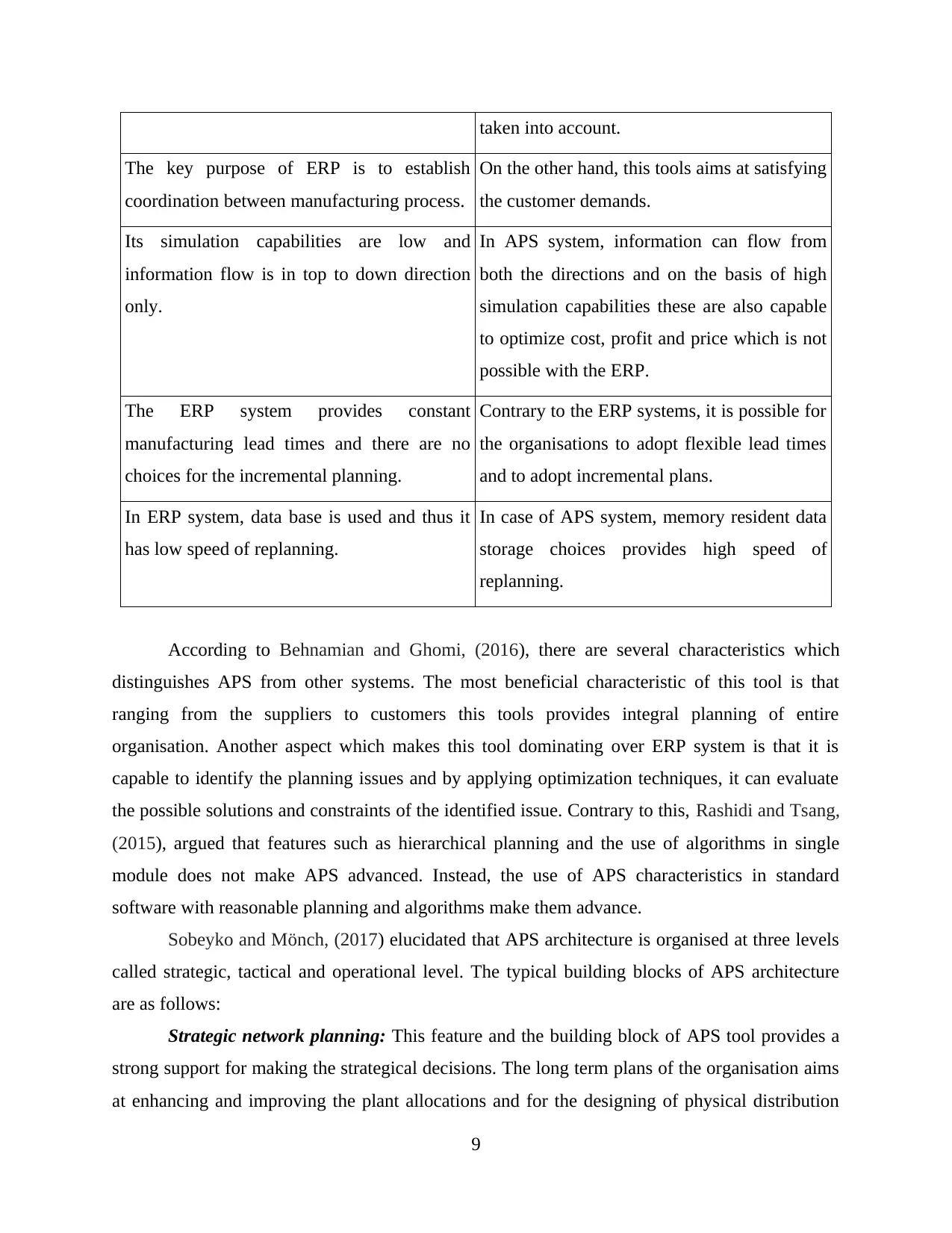
taken into account.
The key purpose of ERP is to establish
coordination between manufacturing process.
On the other hand, this tools aims at satisfying
the customer demands.
Its simulation capabilities are low and
information flow is in top to down direction
only.
In APS system, information can flow from
both the directions and on the basis of high
simulation capabilities these are also capable
to optimize cost, profit and price which is not
possible with the ERP.
The ERP system provides constant
manufacturing lead times and there are no
choices for the incremental planning.
Contrary to the ERP systems, it is possible for
the organisations to adopt flexible lead times
and to adopt incremental plans.
In ERP system, data base is used and thus it
has low speed of replanning.
In case of APS system, memory resident data
storage choices provides high speed of
replanning.
According to Behnamian and Ghomi, (2016), there are several characteristics which
distinguishes APS from other systems. The most beneficial characteristic of this tool is that
ranging from the suppliers to customers this tools provides integral planning of entire
organisation. Another aspect which makes this tool dominating over ERP system is that it is
capable to identify the planning issues and by applying optimization techniques, it can evaluate
the possible solutions and constraints of the identified issue. Contrary to this, Rashidi and Tsang,
(2015), argued that features such as hierarchical planning and the use of algorithms in single
module does not make APS advanced. Instead, the use of APS characteristics in standard
software with reasonable planning and algorithms make them advance.
Sobeyko and Mönch, (2017) elucidated that APS architecture is organised at three levels
called strategic, tactical and operational level. The typical building blocks of APS architecture
are as follows:
Strategic network planning: This feature and the building block of APS tool provides a
strong support for making the strategical decisions. The long term plans of the organisation aims
at enhancing and improving the plant allocations and for the designing of physical distribution
9
The key purpose of ERP is to establish
coordination between manufacturing process.
On the other hand, this tools aims at satisfying
the customer demands.
Its simulation capabilities are low and
information flow is in top to down direction
only.
In APS system, information can flow from
both the directions and on the basis of high
simulation capabilities these are also capable
to optimize cost, profit and price which is not
possible with the ERP.
The ERP system provides constant
manufacturing lead times and there are no
choices for the incremental planning.
Contrary to the ERP systems, it is possible for
the organisations to adopt flexible lead times
and to adopt incremental plans.
In ERP system, data base is used and thus it
has low speed of replanning.
In case of APS system, memory resident data
storage choices provides high speed of
replanning.
According to Behnamian and Ghomi, (2016), there are several characteristics which
distinguishes APS from other systems. The most beneficial characteristic of this tool is that
ranging from the suppliers to customers this tools provides integral planning of entire
organisation. Another aspect which makes this tool dominating over ERP system is that it is
capable to identify the planning issues and by applying optimization techniques, it can evaluate
the possible solutions and constraints of the identified issue. Contrary to this, Rashidi and Tsang,
(2015), argued that features such as hierarchical planning and the use of algorithms in single
module does not make APS advanced. Instead, the use of APS characteristics in standard
software with reasonable planning and algorithms make them advance.
Sobeyko and Mönch, (2017) elucidated that APS architecture is organised at three levels
called strategic, tactical and operational level. The typical building blocks of APS architecture
are as follows:
Strategic network planning: This feature and the building block of APS tool provides a
strong support for making the strategical decisions. The long term plans of the organisation aims
at enhancing and improving the plant allocations and for the designing of physical distribution
9
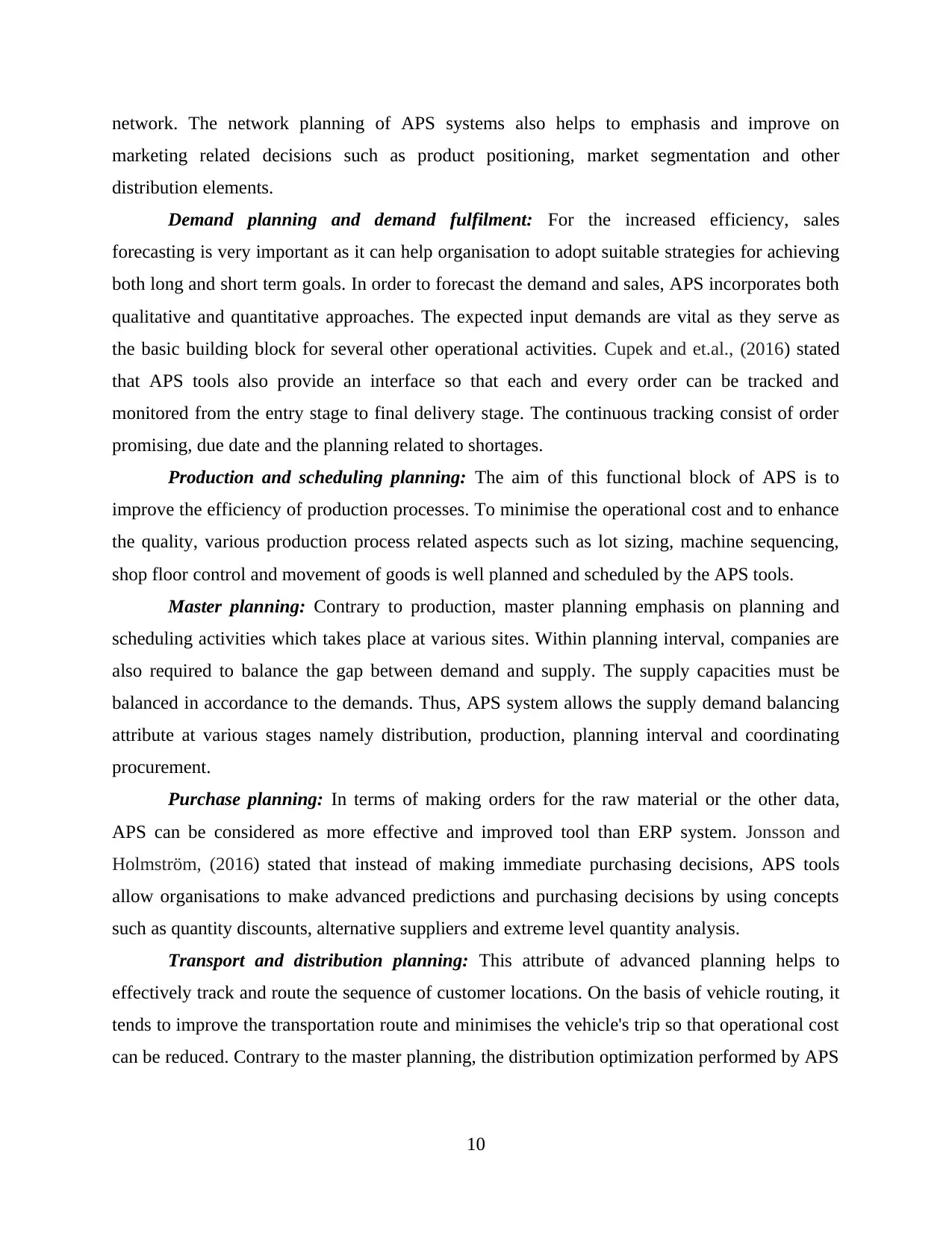
network. The network planning of APS systems also helps to emphasis and improve on
marketing related decisions such as product positioning, market segmentation and other
distribution elements.
Demand planning and demand fulfilment: For the increased efficiency, sales
forecasting is very important as it can help organisation to adopt suitable strategies for achieving
both long and short term goals. In order to forecast the demand and sales, APS incorporates both
qualitative and quantitative approaches. The expected input demands are vital as they serve as
the basic building block for several other operational activities. Cupek and et.al., (2016) stated
that APS tools also provide an interface so that each and every order can be tracked and
monitored from the entry stage to final delivery stage. The continuous tracking consist of order
promising, due date and the planning related to shortages.
Production and scheduling planning: The aim of this functional block of APS is to
improve the efficiency of production processes. To minimise the operational cost and to enhance
the quality, various production process related aspects such as lot sizing, machine sequencing,
shop floor control and movement of goods is well planned and scheduled by the APS tools.
Master planning: Contrary to production, master planning emphasis on planning and
scheduling activities which takes place at various sites. Within planning interval, companies are
also required to balance the gap between demand and supply. The supply capacities must be
balanced in accordance to the demands. Thus, APS system allows the supply demand balancing
attribute at various stages namely distribution, production, planning interval and coordinating
procurement.
Purchase planning: In terms of making orders for the raw material or the other data,
APS can be considered as more effective and improved tool than ERP system. Jonsson and
Holmström, (2016) stated that instead of making immediate purchasing decisions, APS tools
allow organisations to make advanced predictions and purchasing decisions by using concepts
such as quantity discounts, alternative suppliers and extreme level quantity analysis.
Transport and distribution planning: This attribute of advanced planning helps to
effectively track and route the sequence of customer locations. On the basis of vehicle routing, it
tends to improve the transportation route and minimises the vehicle's trip so that operational cost
can be reduced. Contrary to the master planning, the distribution optimization performed by APS
10
marketing related decisions such as product positioning, market segmentation and other
distribution elements.
Demand planning and demand fulfilment: For the increased efficiency, sales
forecasting is very important as it can help organisation to adopt suitable strategies for achieving
both long and short term goals. In order to forecast the demand and sales, APS incorporates both
qualitative and quantitative approaches. The expected input demands are vital as they serve as
the basic building block for several other operational activities. Cupek and et.al., (2016) stated
that APS tools also provide an interface so that each and every order can be tracked and
monitored from the entry stage to final delivery stage. The continuous tracking consist of order
promising, due date and the planning related to shortages.
Production and scheduling planning: The aim of this functional block of APS is to
improve the efficiency of production processes. To minimise the operational cost and to enhance
the quality, various production process related aspects such as lot sizing, machine sequencing,
shop floor control and movement of goods is well planned and scheduled by the APS tools.
Master planning: Contrary to production, master planning emphasis on planning and
scheduling activities which takes place at various sites. Within planning interval, companies are
also required to balance the gap between demand and supply. The supply capacities must be
balanced in accordance to the demands. Thus, APS system allows the supply demand balancing
attribute at various stages namely distribution, production, planning interval and coordinating
procurement.
Purchase planning: In terms of making orders for the raw material or the other data,
APS can be considered as more effective and improved tool than ERP system. Jonsson and
Holmström, (2016) stated that instead of making immediate purchasing decisions, APS tools
allow organisations to make advanced predictions and purchasing decisions by using concepts
such as quantity discounts, alternative suppliers and extreme level quantity analysis.
Transport and distribution planning: This attribute of advanced planning helps to
effectively track and route the sequence of customer locations. On the basis of vehicle routing, it
tends to improve the transportation route and minimises the vehicle's trip so that operational cost
can be reduced. Contrary to the master planning, the distribution optimization performed by APS
10
⊘ This is a preview!⊘
Do you want full access?
Subscribe today to unlock all pages.

Trusted by 1+ million students worldwide
1 out of 33
Related Documents
Your All-in-One AI-Powered Toolkit for Academic Success.
+13062052269
info@desklib.com
Available 24*7 on WhatsApp / Email
![[object Object]](/_next/static/media/star-bottom.7253800d.svg)
Unlock your academic potential
Copyright © 2020–2025 A2Z Services. All Rights Reserved. Developed and managed by ZUCOL.





